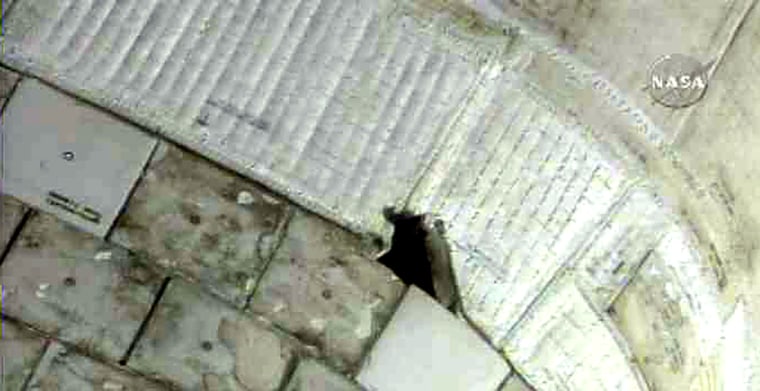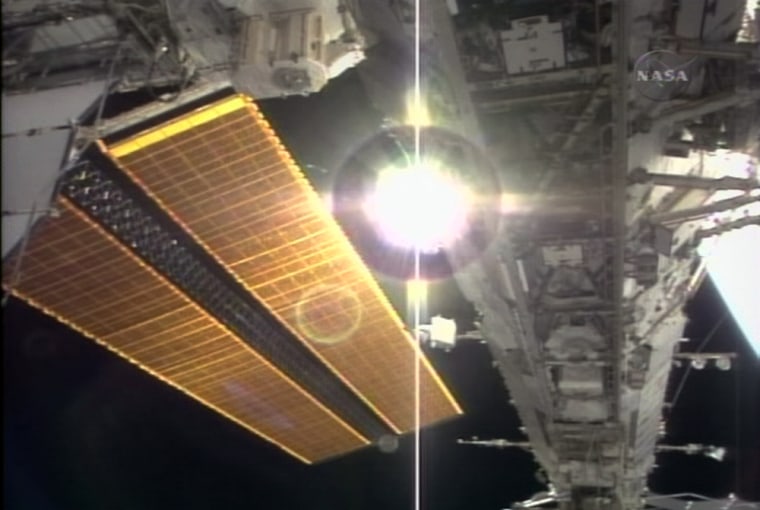Atlantis astronauts may use a sewing kit normally reserved for spacesuits to repair a peeled-back thermal blanket near the spacecraft’s tail, NASA managers said Tuesday.
The shuttle astronauts’ 11-day mission was extended Monday by two days to allow time to fix the thermal blanket, which peeled during launch last week.
No final decision has been made on when the repair, which covers a 4-by-6-inch (10-by-15-centimeter) area over an engine pod, will be made, or what repair technique will be used.
Engineers have looked at using duct tape or other adhesives to secure the blanket, but are leaning toward a method which would use stainless steel wire as thread and an instrument with a rounded end resembling a small darning needle.
“Duct tape doesn’t work in the vacuum of space,” said John Shannon, the mission management team’s chairman.
NASA engineers planned to try out the different method in heat and wind tunnel tests.
The thermal blankets are used to protect the shuttle from searing heat during re-entry. Engineers don’t think the intense heat could burn through the graphite structure underneath it and jeopardize the spacecraft. But it could damage the shuttle, requiring repairs after landing that could delay the three additional flights to the space station NASA has scheduled for the remainder of the year.
Shannon said an investigation has started into how the blanket was secured before launch.
Sensors register impact
The rest of the shuttle appeared to be in fine shape, Shannon said.
Two sensors on the shuttle wing’s leading edge had detected what seemed to be an impact by space debris, but engineers don’t believe anything actually hit the spacecraft’s wing. The highly sensitive sensors have been known to register “ghost” detections in the past from other causes. Shannon said the likeliest cause would be "thermal settling" of the wing panels.
"What we have seen does not indicate that we have been hit by anything," Shannon said. Nevertheless, he said the areas would be given a close check during an inspection session scheduled for June 19.
NASA has been cautious about any potential damage to the wing leading edge since the Columbia disaster in 2003 killed seven astronauts. Foam fell off Columbia’s external fuel tank during launch and punctured the wing, allowing fiery gases to penetrate it during re-entry.
New solar wings make debut
Meanwhile, the international space station’s newest power source — a set of solar wings — made its debut Tuesday.
The solar array is part of a new 17.5-ton space station segment that was connected to the orbiting outpost during a spacewalk Monday.

The solar wings were deployed one at a time, first halfway unfurled and allowed to warm in the sun about 30 minutes. This prevented the solar panels from sticking together.
“We see a good deploy,” astronaut James Reilly, who helped connect the new segment on Monday, said after the second wing was unfurled.
“Good work,” Mission Control said.
The new solar panels were unfolded like an accordion window blind, their orange and black colors reflecting the sunlight.
Each solar wing is 115 feet (35 meters) long and weighs more than 2,400 pounds (1,100 kilograms). The entire solar array’s wingspan is more than 240 feet (73 meters). The array, which converts sunlight to electricity, is the station’s third pair of solar panels.
Overnight Tuesday, while the astronauts on the shuttle slept, engineers at Mission Control began remotely unfolding the array from its storage box.
Brief scares
Shannon said the astronauts' sleep was interrupted overnight when a faulty electronics card triggered an alarm. Then, on Tuesday, a computer software problem triggered a false fire alarm in a Russian module of the space station.
Looking ahead, the crew is due to command an older solar array to be folded up into a box on Wednesday so it can be moved during a later shuttle mission. That array’s retraction will allow the newly installed pair of panels to rotate and follow the sun.
The mission’s second spacewalk was also scheduled to finish activating the station’s new segment on Wednesday. The spacewalkers will be on hand in case the old solar array becomes snagged during the folding-up operation.
Tuesday’s smooth unfurling of the solar wings was in contrast to last September, when a software glitch delayed the unfolding of another set of panels for hours.
This report was supplemented by MSNBC.com.
